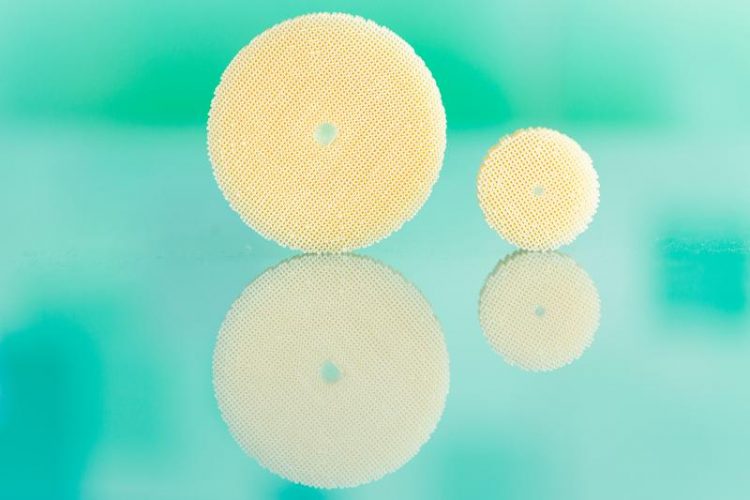Development and Fast Analysis of 3D Printed HF Components

Fraunhofer FHR develops 3D printed high frequency structures and analyses them with SAMMI<sup>®</sup>. Fraunhofer FHR
Compact, affordable, and optimized for specific applications – 3D printing is extremely flexible when it comes to setting the electromagnetic properties of new high frequency systems. One way to achieve this is through the different density distribution of the print material when the component is manufactured using additive processes. These are able to accurately build even the finest of structures, pushing the boundaries of conventional production processes and allowing for completely new HF component designs optimized for individual applications.
One challenge this poses is controlling the quality of the components manufactured using 3D printing technology. In particular, until now, it has been nearly impossible to show the permeability of the manufactured material to high frequency signals. Therefore, Fraunhofer FHR has adapted its high frequency transmitted light system SAMMI® (Stand Alone MilliMeter wave Imager) for the analysis of 3D printed structures.
SAMMI® scans materials and their density distributions, verifying them quickly and reliably. In doing so, SAMMI® not only creates a visualization of the gradients in the material but also makes it easy to detect manufacturing defects. The system is compact, transportable and flexible in its use. Visitors at the Hannover Messe will have a chance to convince themselves of the system on site using material samples.
The SAMMI® measurement and inspection system was developed at Fraunhofer FHR for the scanning of packaged goods in industrial quality control. The system uses millimeter waves to detect differences in materials, the slightest of contaminations, or inhomogeneities in packaged products without contact or ionizing radiation.
This results in a versatile field of application for the high frequency scanner. For instance, SAMMI®, has already been used as the basis for the development of food inspection or mail bomb detection scanners.
Fraunhofer FHR together with six other member institutes of the Fraunhofer Group for Microelectronics presents the Research Fab Microelectronics Germany (FMD) at this year’s Hannover Trade Fair. The Fraunhofer FHR demonstrates the technology competence within the FMD in the field of Heterointegration.
Within the Research Fab Microelectronics Germany (FMD), eleven institutes in the Fraunhofer Group for Microelectronics cooperate with the Ferdinand- Braun-Institut, Leibniz-Institut für Höchstfrequenztechnik and IHP GmbH – Innovations for High Performance Microelectronics in order to offer their customers a comprehensive and simpler access to the next generation of technology.
The Research Fab Microelectronics Germany is the largest cross-site R&D cooperation for micro and nanoelectronics in Europe and offers the world’s largest systems pool for technologies and intellectual property rights within the field of smart systems.
As one of Europe’s leading institutes, the Fraunhofer Institute for High Frequency Physics and Radar Techniques FHR conducts extensive research in the area of high frequency and radar technology. Its core research focuses on sensors for precise distance regulation and positioning as well as imaging systems. The applications range from systems for reconnaissance, surveillance, and protection to real-time capable sensors for traffic and navigation as well as quality assurance and non-destructive testing.
Contact:
Dipl.-Biol. Christiane Weber
Internal und external Communication
Fraunhofer Institute for High Frequency Physics and Radar Techniques FHR
Fraunhoferstraße 20 | 53343 Wachtberg
Telefon +49 151 65675735
mailto: christiane.weber@fhr.fraunhofer.de
http://www.fhr.fraunhofer.de | http://twitter.com/Fraunhofer_FHR
http://www.fhr.fraunhofer.de/hmi_sammi_3d_printing
http://www.fhr.fraunhofer.de/en/businessunits/production.html
Media Contact
All latest news from the category: Trade Fair News
Newest articles

Properties of new materials for microchips
… can now be measured well. Reseachers of Delft University of Technology demonstrated measuring performance properties of ultrathin silicon membranes. Making ever smaller and more powerful chips requires new ultrathin…

Floating solar’s potential
… to support sustainable development by addressing climate, water, and energy goals holistically. A new study published this week in Nature Energy raises the potential for floating solar photovoltaics (FPV)…

Skyrmions move at record speeds
… a step towards the computing of the future. An international research team led by scientists from the CNRS1 has discovered that the magnetic nanobubbles2 known as skyrmions can be…





















